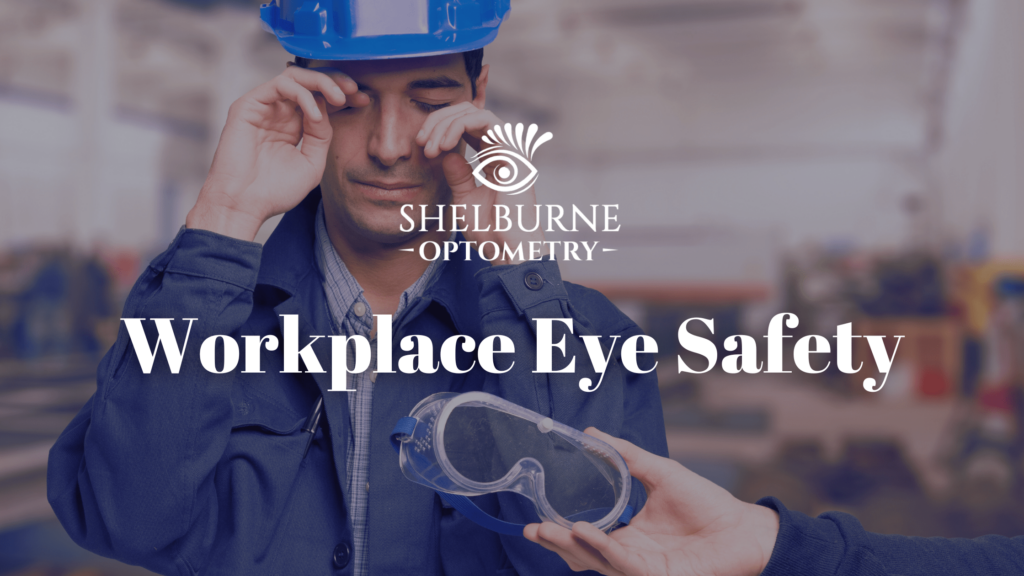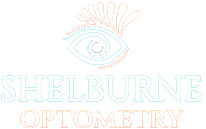Spring is in the air outside my office window, our maple tree suddenly filled with birds and sunlight after a rather dreary winter. I sip my coffee, wondering at the simple beauty of it all.
And then it happens.
From the other side of the house, a crash. A bang. Inaudible obscenities exchanged. I enter the scene to find the hierarchy of the living room cat tree under violent debate. Tiny fangs and murder mittens fly, and like a referee in a poorly scripted wrestling match, I know anything could happen.
As someone who works from home, this is about as intense as my risk of workplace injury gets.
For the rest of the country, according to the Canadian Association of Optometrists, over 700 eye injuries (just eye injuries!) occur every single day, and over 200 of them happen in the workplace. Most of them are entirely preventable if not completely avoidable (it’s literally estimated that 90% of them are preventable).
If you’ve read our blog before, you know we love bringing attention to the various ways we recklessly endanger our eyeballs every day. This is one of those posts.
Common Workplace Eye Injuries
Before we dive right in, here’s a list of some common eye injuries that can occur in the workplace:
- Bleeding
- Burns (from chemicals, fire, hot water, cooking oil, etc.)
- Flash Burns (UV exposure, especially in welding)
- Hyphema (bleeding between the iris and cornea – the coloured part of your eye and the transparent protective layer at the front of your eye)
- Iritis (inflammation of the iris)
- Penetration (OW)
- Radiation
- Scraping
- Scratched Cornea
- Swelling
The jobs that carry the highest risk of eye injury are:
- Automotive
- Carpentry
- Chemical Work
- Construction
- Electrical
- Maintenance
- Manufacturing
- Mining
- Plumbing
- Welding
Sharp Things, Fire & Debris
Foreign objects in the eye are one of the most common eye injuries that exist. From dirt to full-on Christmas trees, we’ve literally seen it all. The workplace is no different. It’s estimated that up to 70% of serious workplace eye injuries can be caused by things flying at a worker’s face, most of which are too small to see coming. Proper workplace training is crucial to making workers aware of these dangers, so they know the risks whether they see them coming or not.
Many workplaces employ the use of tools, which almost always bring a risk of debris, especially in any kind of industrial or construction work. Wood, metal, cement dust, dirt, drywall, glass, plexiglass and more can release small (or large) particles that won’t get along with your eyes. All of these can be avoided with proper safety eyewear. Many workplace safety glasses require permanent side-shields to offer the most protection (we also highly recommend them, but more on that later).
Workers need to be undistracted and fully focused on their tasks to ensure proper use of sharp objects and tools, and minimise (if not entirely eliminate) the risk of injury. Louis Braille, the man who designed the tactile code of raised dots people with blindness still use to read, lost his own eyesight in this manner (improperly using tools in his father’s shop).
Fire also poses a risk: sparks and embers are the most obvious danger, especially when a worker gets too close without proper safety equipment. But there’s also the risk of any molten materials splashing or spraying, as well as the heat itself, which can lead to tissue damage from thermal burns (ow).
Metal in the Eye
This is one of the most common workplace-eye-injury calls that we receive. A shard, shaving or speck of metal finding its way into someone’s eye (staples, anyone?). Metal causes a unique risk due to its sharpness and potential for carrying rust.
If you suspect you have metal in your eye, you need to get it looked at as soon as possible. Do not rub your eye, and do not try to remove it yourself. Metal should only be removed by a trained professional with the proper tools or more damage is risked. Contact the nearest optometry or ophthalmology office, or get to an emergency room (the hospital will have an on-call ophthalmologist).
Even if the metal successfully fell out, there’s still the risk of rust particles causing more damage or leading to an infection. Do not ignore the risks of metal in your eye.
A Note on Foreign Object Sensation
Ah, my favourite dry eye symptom. Truly a mystery wrapped in an enigma, the thrilling symptom of foreign object sensation occurs when your eye is so dry it literally feels like there’s something physically in there, but there isn’t.
The reason I feel this is worth mentioning is simply because of the amount of patients we’ve seen who are sure they got something in their eye at work, but an examination shows nothing there. This can occur when the work environment is excessively dry; dusty workplaces or spaces using air-based heating systems, like the cab of a work vehicle in winter, are common culprits.
The most important thing to remember is that if this feeling occurs, and you think there may be something in your eye, do not go digging around in there on the hunt for a source without thoroughly washing your hands first. In fact, clean hands work better for holding your eye open to look in a mirror than actually touching your eyeball anyway. When possible, have someone else give you a (clean) hand to see if there’s anything in there.
Welding Flashes (Flash Burns)
While we’re discussing tools and debris and fire and fun, it’s worth mentioning welding flashes. These occur when your eyes are exposed to the bright light of a welding arc without proper protection. Also known as ultraviolet keratitis, flash burns are basically like a severe sunburn to the surface of your eye. They can lead to changes in vision, or even loss of vision, especially if an infection sets in.
While flash burns can be caused by any UV light (leading to painful inflammation of the cornea), welding flashes are the most common, leading to the condition being named “welder’s eye” or “arc eye”.
Other causes of flash burns can include:
- Direct Sunlight
- Flood Lamps (such as the kind used in photography)
- Glassblowing
- Halogen Lamps
- Lightning Strikes
- Reflections (such as off metal or glass surfaces, water, or snow)
- Solar Eclipses
- Tanning Beds
Invisible Dangers
So we covered projectiles and dangerously bright lights, but what about the dangers we actually can’t see? Not specks of dust and debris, but spatial dangers that don’t always carry a physical form to be noted? Just because you can’t see it, doesn’t mean it isn’t there.
Chemicals & Fumes
Chemical burns and irritation from fumes are common workplace eye injuries, simply because the danger isn’t always ocularly obvious. Chemical injuries can occur from splashes, touching your eyes with contaminated hands, getting debris or objects in your eye that have come into contact with chemicals, or exposure to strong fumes.
Common chemical injuries include conjunctivitis (pink eye), corneal ulcers, surface burns and tissue damage. Some of the most common culprits for causing these injuries include:
- Acids
- Ammonia
- Bleach
- Cement
- Cleaners
- Detergents
- Fertilisers
- Lime (not the fruit, though that can burn too; this refers to the inorganic material composed primarily of calcium oxides and hydroxides)
- Lye (an alkaline liquor most commonly found in soapmaking)
Radiation
Radiation exposure includes the UV light that causes the flash burns we mentioned above, but there’s also the invisible radiation risked when working with things like x-ray equipment, or undergoing radiation treatments, and beta rays for those handling certain nuclear substances.
Workplace Eye Injury Prevention
Protecting your eyes at work is a wildly simple practice. Sadly, a lot of workers ignore the simplicity of it out of laziness, which ends up costing them.
In some cases, proper personal protective equipment (PPE) isn’t supplied by the employer. In these instances, the workers should absolutely bring it to someone’s attention. Employers are required by law to ensure all employees are aware of all potential risks and dangers, provide proper training on handling any dangerous work or substances, and provide any equipment needed to do so safely.
Some workplaces will provide guidelines for workers to purchase their own safety equipment such as work boots or safety glasses, and reimburse them a percentage of the cost. It’s extremely important that all safety equipment have the Canadian Standards Association (CSA) certification mark on them. It will look like this:
PPE for Eye Protection
The best types of PPE to protect your eyes against workplace injury are:
- Barriers between workspaces or potential risks such as chemicals or certain types of machinery
- Face Shields
- Goggles
- Helmets (we recommend combining these with another form of eye PPE)
- Safety Glasses
Safety Glasses
The most obvious piece of PPE you can wear to prevent workplace eye injury is, unsurprisingly, safety glasses. Goggles are also handy, depending just how much surface protection you may need.
Safety glasses were once a one-size-fits-all area, but they’ve come a long way in both size and functionality. They’re more accessible and available in multiple sizes, shapes and colours, depending on your specific needs or preferences. Some can even be made with prescription lenses, to offer the best visual acuity to support awareness of the workspace while also protecting against potential injury.
Side shields are sometimes built-in to the safety glasses frames themselves, others are detachable, in case you don’t always need them. We like side shields because they add a protective layer across the side of the eye, enclosing the gap left from the front of the frame to the side of the head. This offers additional protection against debris, splashes and other projectiles. They also offer more protection during falls or potential equipment failure. We like side shields.
Contact Lenses Are Not Protective Eyewear
Y’all… *sigh*
I don’t know who told you that that 14mm piece of silicone hydrogel was gonna protect your eyeball from injury of any kind, but they lied. They lied real bad.
Contact lenses are not protective eyewear.
Safety glasses or bust.
Final Thoughts
Did you know one of the top reasons people choose not to wear safety glasses is “looking uncool”? If you read our post about eye safety in sports, you already know how much no one in the emergency room is gonna care about how “cool” you are when you’re sitting there with a dixie cup taped to your face.
Along with the rest of your physical senses, your eyes have an important role to play in the formation of your happy memories and life-changing experiences. Don’t risk them by cutting corners on eye safety. Awareness is your best tool: get proper training and wear proper protective equipment.
It’s worth it, I promise.
Wishing you all the best in wherever your path takes you today,
Sydney Gallant, CCOA









